What Are Shopify Test Orders? How to Create, Test, and Manage Them in 2025
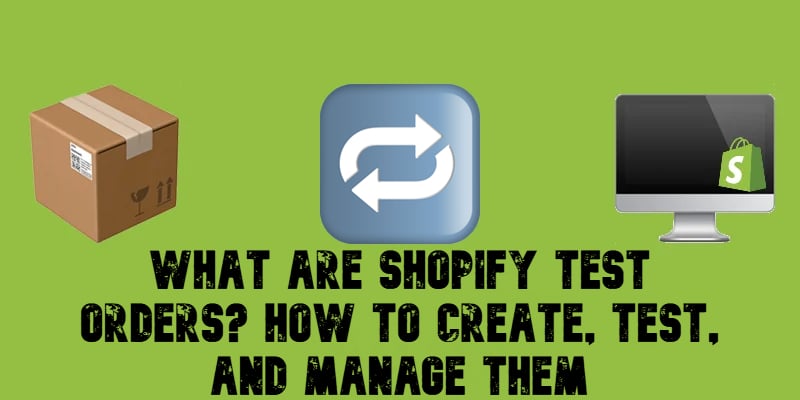
Launching a Shopify store or making significant changes to your checkout process can be exciting, but how can you be sure everything works smoothly? This is where Shopify test orders come in. Test orders allow you to experience the checkout process exactly as your customers would but without processing real payments. They’re the safest way to troubleshoot potential issues, verify payment methods, and ensure a seamless shopping experience before going live.
From checking if discount codes apply correctly to confirming that shipping rates calculate as they should, test orders help you catch mistakes early. They are especially important when rolling out updates or integrating new features, as even small changes can affect the checkout flow. Understanding how to create, manage, and remove test orders will keep your Shopify admin clean and organized.
In the following sections, we’ll cover what Shopify test orders are, how they differ from draft and live orders, how to create and remove them, and how to troubleshoot common issues to keep your checkout process running smoothly.

Table of contents
- What Are Shopify Test Orders?
- How to Do Test Orders on Shopify in 2 Easy Steps
- How to Create Shopify Test Orders For Third-Party Payment Providers
- How to Create Shopify Test Orders with Bogus Gateway
- How to Remove Test Orders from Shopify
- Common Problems with Shopify Test Orders and How to Solve Them
- Final Words: Why Regular Testing is Crucial for Shopify Success
- FAQ
What Are Shopify Test Orders?
Ever wondered how you can be sure your Shopify checkout process works flawlessly before launching your store or making changes? That’s where Shopify test orders come in. Test orders are simulated transactions that let you experience your checkout process just like a real customer would — without charging a credit card or processing an actual payment.
These mock orders are crucial for identifying and fixing potential issues before your customers encounter them. Whether you’re testing different payment gateways, verifying custom checkout settings, or ensuring your shipping rates are correctly configured, test orders give you the confidence to launch your store without surprises.
But how do test orders differ from live orders or draft orders? Let’s see!
| Test Orders | Order Drafts | Live Orders | |
| Purpose | Simulate checkout process and payment scenarios | Create manual orders or pre-orders for customers | Actual customer-placed orders |
| Sales Data | No impact on sales reports or analytics | No immediate impact until converted to live order | Included in sales reports and analytics |
| Inventory | No inventory reservation | Reserves inventory while the draft exists | Reduces inventory upon order creation |
| Payment Requirement | Uses test credit card numbers or bogus gateway | Requires manual payment entry or sending an invoice | Requires actual payment from customers |
| Refund Capability | No real refunds (simulated only) | Refunds available after converting to live order | Full refund capabilities |
| Order Status | Test orders marked as “Test” or archived after completion | Draft status until submitted as a real order | Fulfilled, unfulfilled, or partially fulfilled |
| Availability | Available for all stores (via test mode or bogus gateway) | Available in Shopify admin for all merchants | Automatically created when a customer places an order |
| Customer Experience | Simulates a real customer checkout experience | No customer interaction until invoice is sent | Real customer interaction |
| Best Use Case | Testing checkout flow, payment methods, shipping rates | Creating custom orders, wholesale orders, pre-orders | Fulfilling real orders and processing payments |
Unlike real orders or drafts, test orders don’t affect your sales metrics or inventory. They’re designed purely for testing purposes. You can simulate transactions for major payment methods like credit cards, PayPal, and manual payments. Want to check if a discount code applies correctly? Or verify how shipping costs calculate for different regions? Running test orders will help you catch mistakes early and perfect your customer experience.
And here’s the best part: Shopify provides tools to make testing your store simple and straightforward. From test modes to bogus payment gateways, you can test almost every aspect of your store without needing to go live.
Curious about how to create a test order on Shopify? Let’s walk through it in the next section:
How to Do Test Orders on Shopify in 2 Easy Steps
Now that you know what test orders are and why they’re essential, it’s time to get hands-on! Creating a test order in Shopify is a straightforward process. Ready to test your checkout like a pro? Let’s dive in!
Step 1: Enable Test Mode for Shopify Payments
If you’re using Shopify Payments, enabling test mode is the safest way to simulate transactions without charging your credit card. Here’s how:
- Go to Settings > Payments in your Shopify admin.
- Click Manage under Shopify Payments.
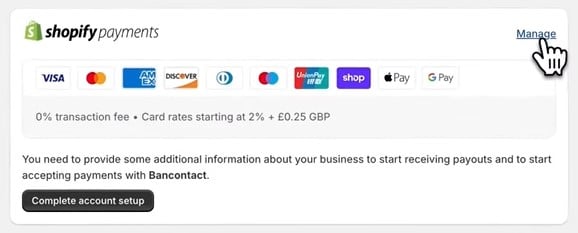
- Scroll down and check the box for Enable test mode.
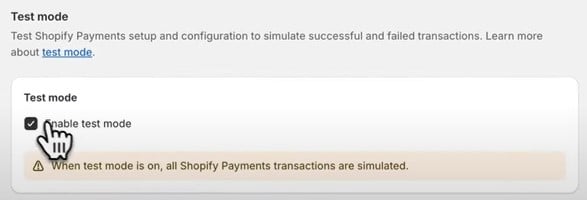
- Click Save.
Once test mode is enabled, you can simulate test orders by entering dummy credit card numbers provided by Shopify. Remember, while test mode is active, real transactions won’t be processed — so don’t forget to turn it off after testing!
Step 2: Create Shopify Test Orders to Simulate Successful and Failed Transactions
Head to your storefront, add a few products to your cart, and proceed to checkout to experience how Shopify’s test order functionality works in real time.
While testing, be sure to simulate both successful and failed transactions. This will give you a complete picture of how your store handles various payment scenarios — helping you catch potential issues before your customers do.
Simulating a Successful Transaction
You can’t use random card numbers to simulate a successful test order in Shopify. Instead, use the specific test details below during checkout:
- Name on card: Enter at least two words.
- Expiry date: Use any future date.
- Security code: Enter any three digits.
- Card number: Use one of the test numbers below based on the card type:
- Visa: 4242 4242 4242 4242
- Mastercard: 5555 5555 5555 4444
- American Express: 3782 822463 10005
- Discover: 6011 1111 1111 1117
- Diners Club: 3056 9309 0259 04
- JCB: 3530 1113 3330 0000
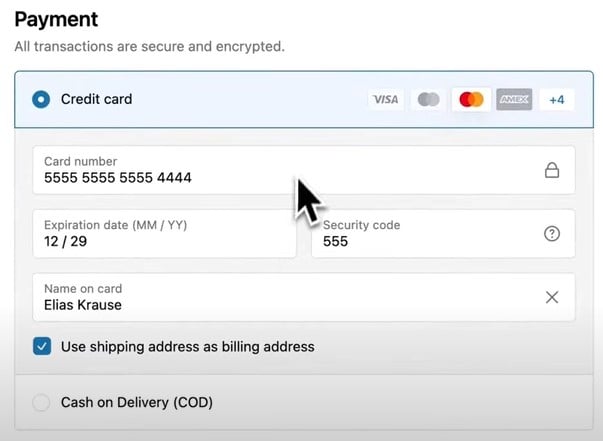
After completing the checkout process with one of these test numbers, you’ll see the order marked as successful in your Shopify admin.
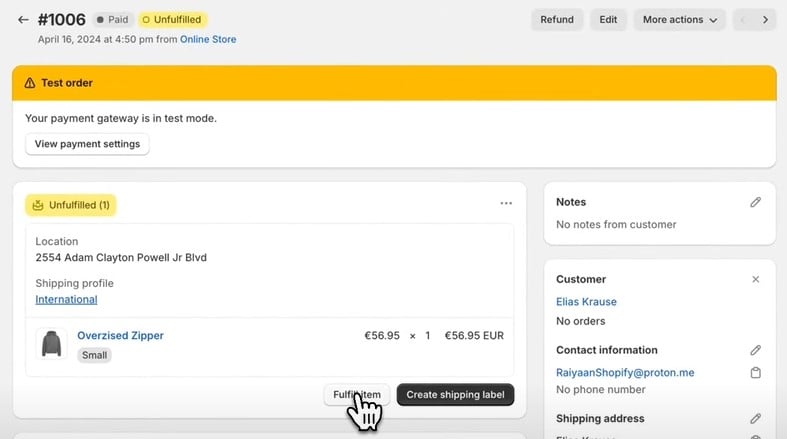
Simulating a Failed Transaction
Want to see how your store handles errors during checkout? You can simulate various failed transactions using specific test credit card numbers or incorrect details. Here are some common scenarios:
- Card Declined: Use credit card number 4000 0000 0000 0002.
- Incorrect Card Number: Use 4242 4242 4242 4241.
- Disputed Transaction: Use 4000 0000 0000 0259.
- Invalid Expiry Month: Enter a month beyond 12, like 13.
- Invalid Expiry Year: Use any year in the past.
- Invalid Security Code: Enter a two-digit number instead of three digits.
By simulating these errors, you can see the exact messages your customers might encounter — giving you a chance to fix potential issues and improve the user experience. Watch the following video for the detailed description of the testing process:
How to Create Shopify Test Orders For Third-Party Payment Providers
Using a third-party gateway like PayPal or Stripe? Testing isn’t as direct as with Shopify Payments, but it’s still possible! Most third-party providers offer a sandbox environment for testing.
Here’s what you’ll do:
- Visit your payment provider’s documentation to set up a sandbox account.
- Create a test transaction through their interface.
- Verify the order in your Shopify admin to see how it integrates with your store.
If your provider doesn’t offer test options, consider using the bogus gateway method outlined below for a more flexible approach.
How to Create Shopify Test Orders with Bogus Gateway
For ultimate flexibility, Shopify offers a bogus gateway. It allows you to simulate a test transaction without needing Shopify Payments or a third-party provider. Here’s how to set it up:
- Go to Settings > Payments in your Shopify admin.
- In the Additional payment methods section, click Add payment method and then select Bogus Gateway on the next screen. Note that it won’t be available if you have Shopify Payments enabled.
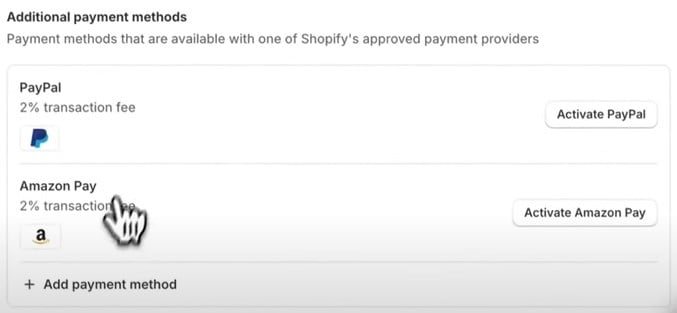
- Follow the on-screen instructions to enable the bogus gateway.
- Go to your store and create a test order as a customer would.
Use these test credit card numbers to simulate different results:
- Successful transaction: 1
- Failed transaction: 2
- Error transaction: 3
Enter Bogus Gateway as a card name. You can use any 3-digit number as CVV and any expiry date in the future
After placing the test order, check the Orders section in your Shopify admin to review how the order appears. This gives you valuable insights into your order fulfillment process.
Curious about how to remove test orders from Shopify? That’s exactly what we’ll cover in the next section:
How to Remove Test Orders from Shopify
After running a few test orders, your Shopify admin might start to look a little cluttered. Can you delete these test orders to keep things clean? Not exactly — but you can archive or cancel them to remove them from the active order list. This way, your Shopify admin stays organized and easy to manage without affecting your order history.
Archiving Shopify Test Orders
Since Shopify doesn’t allow you to permanently delete orders, archiving is the most effective way to keep your admin tidy. Archiving hides the test orders from your main order view but keeps them accessible if you ever need to reference them later.
Here’s how to archive a test order:
- Go to your Orders page in the Shopify admin.
- Click on the test order you want to archive.
- Click More actions > Archive order.

Once archived, these orders will no longer appear in your active order list but can still be found under Archived orders.
Even though archiving helps declutter your admin, it’s wise to keep a couple of test orders around for reference. They can serve as useful examples when training staff or troubleshooting future order issues.
Canceling Test Orders in Shopify
If you prefer, you can cancel test orders instead. Canceling an order marks it as incomplete and prevents further action, such as fulfillment or refunds. While it won’t completely remove the order, it signals that it’s no longer active.
Steps to cancel a test order:
- Go to Orders in your Shopify admin.
- Select the order you want to cancel.
- Click More actions > Cancel order.

Combine archiving and canceling for maximum organization. Cancel the test order first, then archive it to keep your order history clean.
In the next section, we’ll explore several common problems associated with Shopify test orders along with corresponding troubleshooting, so you can streamline your testing process and avoid common mistakes. Ready to take your Shopify testing to the next level? Let’s continue!
Common Problems with Shopify Test Orders and How to Solve Them
Even with Shopify’s robust testing tools, you might encounter a few bumps along the way. From test mode not working to orders that mysteriously fail to appear in your admin, these issues can be frustrating — but don’t worry! Most problems have straightforward solutions. Let’s explore the most common issues and how to fix them.
1. Test Mode Not Working
You’ve enabled test mode for Shopify Payments, but your test transactions still behave like live payments.
Solution:
- Double-check that test mode is enabled in your Shopify admin by navigating to Settings > Payments > Manage.
- Ensure you’re using the correct test credit card numbers provided by Shopify. Random numbers won’t work.
- If you’re testing a third-party provider, make sure you’ve set up its sandbox environment for testing.
2. Test Orders Not Appearing in Admin
You placed a test order, but it doesn’t show up in your Orders section.
Solution:
- Confirm that the order process was fully completed. Did you reach the confirmation page?
- If you’re using a development store, verify that the transaction was properly simulated using test mode or the bogus gateway.
- Check your order filters in the admin. The order may be hidden by a filter, especially if it’s archived or canceled.
3. Incorrect Test Results for Shipping Rates or Discounts
The shipping rates or discounts applied during your test order don’t match your settings.
Solution:
- Review your Shipping and Delivery settings to ensure your shipping profiles are configured correctly.
- Double-check discount conditions — such as order minimums or product-specific discounts — in your Discounts section.
- Simulate multiple test orders with different shipping destinations and cart values to catch inconsistencies.
4. Error Messages During Checkout
You encounter unexpected error messages like “Invalid card number” or “Payment failed” during your test transaction.
Solution:
- Use the correct test card numbers for each scenario.
- If testing third-party providers, errors might come from their sandbox environment. Refer to their documentation for specific error codes and solutions.
5. Unable to Test Refunds or Cancellations
You want to test refunds or order cancellations, but Shopify doesn’t seem to process them in test mode.
Solution:
- Test refunds and cancellations only on existing test orders that were successfully created.
- If you’re in a development store, the refund process is simulated, so there won’t be a real payment reversal.
Don’t let small issues stop you from perfecting your Shopify store. Keep testing multiple scenarios and documenting your results — it’s the best way to ensure a seamless experience for your customers.
Final Words: Why Regular Testing is Crucial for Shopify Success
Your Shopify store’s checkout process is the heart of your business. Ensuring that it runs smoothly isn’t just a one-time task — it’s something you should revisit regularly. Shopify test orders are a powerful way to catch issues before they affect your customers, helping you maintain a seamless shopping experience and protect your sales.
Planning a major update? Adding a new payment gateway or shipping method? Every change is an opportunity to test and optimize. Regular testing not only improves your checkout but also gives you peace of mind, knowing your store is always ready to handle transactions flawlessly.
Don’t just stop at testing — streamline your order management too! The can automate order exports and simplify fulfillment by allowing bulk imports. Whether you’re managing a handful of orders or thousands, this tool can save time and reduce errors.
Ready to take your order management to the next level? Contact us for more information on how the Import & Export tool can help you optimize your Shopify store. Regular testing and smart automation are your best allies in running a successful Shopify store. Keep testing, optimizing, and growing your business with confidence!
FAQ
What Are Shopify Test Orders?
Shopify test orders simulate real customer transactions, allowing you to test your store’s checkout process without charging a credit card or affecting your sales data. They’re essential for identifying potential issues with payment methods, shipping rates, and discount codes.
Why Should I Use Shopify Test Orders?
Test orders help ensure your checkout works seamlessly before launching your store or after making updates. They reduce the risk of errors that could disrupt the customer experience or result in lost sales.
How Do Shopify Test Orders Differ from Live Orders?
Unlike live orders, test orders don’t impact your sales reports or reduce inventory. They are purely for testing purposes and can be archived once you’ve completed your testing process.
How Do I Create a Shopify Test Order?
You can create a test order by enabling test mode for Shopify Payments or using the bogus gateway. This allows you to simulate various payment scenarios without processing real transactions.
Can I Delete Test Orders in Shopify?
No, Shopify doesn’t allow you to permanently delete orders, but you can archive or cancel them to keep your admin organized. Archiving hides the orders from your active list while retaining access for future reference.
How Do I Test Third-Party Payment Providers in Shopify?
To test third-party providers like PayPal or Stripe, use their sandbox environments. These simulate transactions outside Shopify’s test mode, ensuring your integration works as expected.
What Common Issues Can Occur with Shopify Test Orders?
Some common problems include test orders not appearing in your admin, incorrect shipping rates, and error messages during checkout. Most issues are caused by incorrect test mode settings or incomplete test order processes.
How Can I Test Failed Transactions?
Use specific test credit card numbers to simulate failed transactions. For example, entering 4000 0000 0000 0002 will generate a card declined message, helping you verify how errors appear to customers.
Should I Test Orders Regularly?
Yes! Regular testing is crucial, especially after major changes like adding new payment methods, updating shipping settings, or installing new apps. Continuous testing ensures your checkout is always running smoothly.
How Can I Streamline Shopify Order Management?
Consider using tools like the Import & Export tool for automated order exports and bulk order fulfillment. These tools save time and reduce manual errors, keeping your operations efficient and organized.








